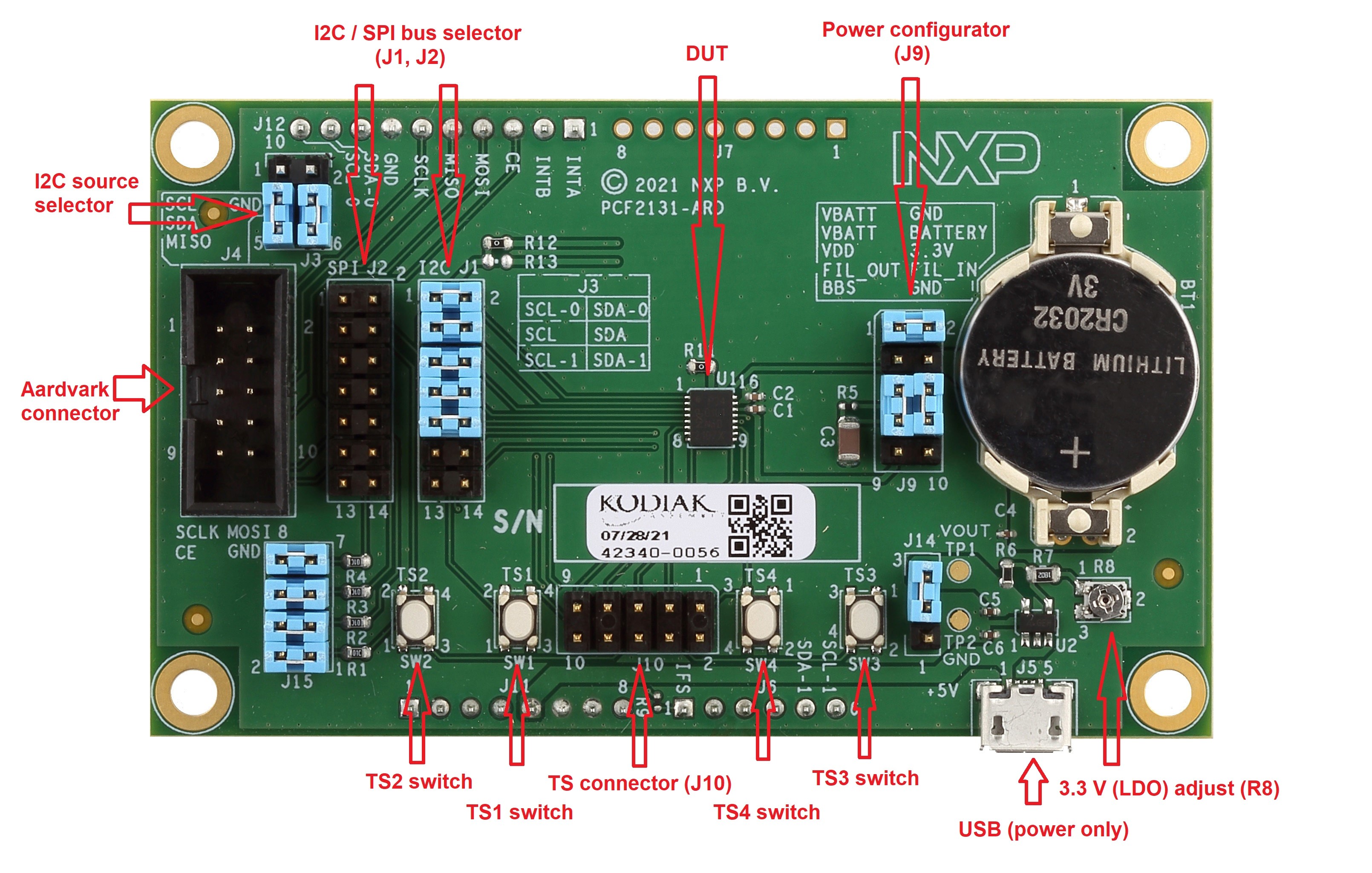- Analog Toolbox
- Getting Started with the PCF2131-ARD Evaluation Board
Getting Started with the PCF2131-ARD Evaluation Board
Contents of this document
-
Out of the Box
-
Get Hardware
-
Install Software
-
Configure Hardware
Sign in to save your progress. Don't have an account? Create one.

Purchase your PCF2131/PCA2131 Arduino® Shield Evaluation Board
1. Out of the Box
The NXP analog product development boards provide an easy-to-use platform for evaluating NXP products. The boards support a range of analog, mixed-signal and power solutions. They incorporate monolithic integrated circuits and system-in-package devices that use proven high-volume technology. NXP products offer longer battery life, a smaller form factor, reduced component counts, lower cost, and improved performance in powering state-of-the-art systems.
This page will guide you through the process of setting up and using the PCF2131-ARD evaluation board.
1.1 Kit Contents and Packing List
The PCF2131-ARD contents include:
- Assembled and tested evaluation board in an anti-static bag
- Quick Start Guide
1.3 Static Handling Requirements
CAUTION
This device is sensitive to electroStatic discharge (ESD). Therefore care should be taken during transport and handling. You must use a ground strap or touch the PC case or other grounded source before unpacking or handling the hardware.
1.4 Minimum System Requirements
This evaluation board requires a Windows PC workstation. Meeting these minimum specifications should produce great results when working with this evaluation board.
- PC with Windows 10 operating system
- One USB port (either 3.0 or 2.0 or 1.1 compatible)
- One of three EVK boards (MIMXRT1050-EVK, LPC55S69-EVK, 8MMINILPD4-EVK) along with the associated firmware / GUI software
- USB cable for power and data connection between PC and EVK board (if not included in the EVK package)
2. Get Hardware
2.1 Board Features
- Equipped with Arduino™ Uno R3 port for direct connection with Arduino devices
- Onboard header for direct connection to Aardvark I²C/SPI Host Adapter
- Adjustable power supply for complex tests and verification
- Onboard battery holder for battery switch-over circuit test
- Onboard jumpers for I²C-bus or SPI-bus selection
- Onboard connector and switches for timestamp function tests
- Fully compliant with IMXRT1050 EVK board, including GUI (Windows 10)
- Fully compliant with LPCXpresso55S69 development board, including GUI (Windows 10)
- Compliant with 8MMINILPD4-EVK board, including GUI for Windows 10 (see Note)
2.2 Board Description
The evaluation board is built around the PCF2131TF IC, a CMOS Real-Time Clock (RTC) and calendar with an integrated Temperature Compensated Crystal Oscillator (TCXO) and a 32.768 kHz quartz crystal optimized for high accuracy and ultra-low power consumption. The PCF2131TF has a selectable I²C-bus or SPI-bus, a backup battery switch-over circuit, a programmable watchdog function, four timestamps function, and other features. For more details, see the PCF2131 data sheet. The PCF2131-ARD works as a daughter card which can be connected through an ARDUINO port to various ARDUINO compatible (including original ARDUINO UNO R3) boards. Alternatively, the board can be connected through a dedicated connector to an Aardvark USB to I²C/SPI host adapter, allowing for rapid tests of the DUT IC. The board is equipped with battery holder and adjustable voltage regulator, to allow the user to test the RTC over the entire range of power supply voltage, and the battery switch-over circuit.
The RTC communicates with the controller / microprocessor through a bidirectional Fm I²C-bus. When the daughter card is connected through the Arduino port to one of the following NXP evaluation boards: operated through the Among the device under test (DUT) IC, the board is equipped with an ARDUINO port and the necessary components for easy testing, shortening the time to make measurements and check operation of the PCF2131TF IC.
Additionally, the daughter board has software support and a graphical user interface (Windows platform) for the following NXP evaluation boards: IMXRT1050 EVK board, LPCXpresso55S69 Development board and i.MX 8M Mini LPDDR4 EVK board. All three above mentioned evaluation boards contains Arduino ports, allowing the user to attach and operate from the GUI the PCF2131-ARD daughter board.
3. Install Software
3.1 Install Software
PCF2131-ARD evaluation board is designed and built as a daughter board able to work with a mother board equipped with an Arduino port. The board is built to be fully compatible with the following NXP evaluation boards:
Each of the above evaluation/development boards is supported by firmware that can be downloaded from the PCF2131/PCA2131 Evaluation Board page. Before beginning to use a paired EVK – PCF2131-ARD configuration, the EVK motherboard must be programmed with the corresponding firmware package. Additionally, a GUI application (Windows 10) is available for download from the NXP site, allowing rapid testing and operation of the PCF2131-ARD daughter board in conjunction with the EVK.
For details regarding installation of the EVK firmware and GUI host software, see UM11581, Arduino shields GUI and firmware installation manual .
Once the software is installed, the first step is to select the correct EVK from the graphical interface. The board can then be controlled from the GUI interface.
4. Configure Hardware
4.1 Configure Hardware
The following steps are suggested to setup the hardware before first use:
-
Select the communication bus
- Select the I²C-bus Arduino source (
J3) -
Select interface jumpers, either using I²C
interface (
J1) or SPI interface (J2)
- Select the I²C-bus Arduino source (
- Place coin battery CR2032 into
BT1battery socket - Remove jumper on
J9.1and 2, and move it toJ9.3and 4 -
Select correct power supply source on
J14. (1 and 2) = Arduino, (2 and 3) = Micro USB -
Select correct power supply source on
J14. (1 and 2) = Arduino, (2 and 3) = Micro USB-
Apply 5.0 V power to
J5using a micro USB cable and plug in Aardvark/Promira/ FTDI host controller cable toJ4. Make sure 5.0 V supply is plugged in before connection the host controller cable -
Or Plug
J11andJ12into a microcontroller’s Arduino headers and supply the microcontroller kit with USB power through the PC
-
Apply 5.0 V power to


